How to remove OpticalUpdater adware from the operating system
Mac VirusAlso Known As: Ads by OpticalUpdater
Get free scan and check if your device is infected.
Remove it nowTo use full-featured product, you have to purchase a license for Combo Cleaner. Seven days free trial available. Combo Cleaner is owned and operated by RCS LT, the parent company of PCRisk.com.
What is OpticalUpdater?
OpticalUpdater is an adware-type application with browser hijacker traits. Following successful infiltration, it runs intrusive advertisement campaigns and promotes fake search engines by modifying browser settings. Additionally, most adware-types and browser hijackers collect browsing-related information.
Typically, users download/install OpticalUpdater unintentionally and, therefore, this app is classified as a Potentially Unwanted Application (PUA).
This piece of software has been observed being spread via fake Adobe Flash Player updates. Note that bogus software updaters/installers are also used to proliferate malware (e.g., trojans, ransomware, etc.).
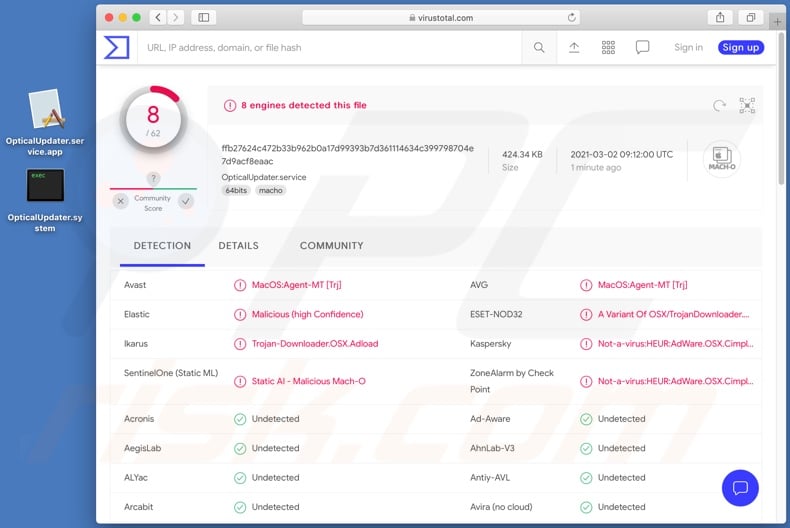
OpticalUpdater adware overview
Adware enables the placement of pop-ups, banners, coupons, surveys, and other intrusive ads, typically on any visited website (or different interfaces). These ads significantly diminish the browsing experience by reducing browsing speed and limiting site visibility (by overlaying page content). Furthermore, when clicked, intrusive advertisements redirect to various untrusted/malicious websites and some can stealthily download/install software (e.g., PUAs).
Browser hijackers assign fake searcher addresses as the homepage, default search engine, and new tab/window URLs. With this software installed, every new browser tab/window opened and web search done via the URL bar redirects to the promoted address. Bogus search engines seldom can provide search results, and so they redirect (or cause redirection chains ending with) Yahoo, Bing, Google, and other genuine sites.
Browser hijackers can also undo any changes users try to make to their browsers and restrict/deny access to the browser settings. Therefore, recovering an affected browser is impossible without removing the software hijacking it.
Furthermore, most PUAs (adware and browser hijackers included) have data tracking capabilities. They monitor browsing activity (URLs visited, pages viewed, search queries typed, etc.) and gather vulnerable information extracted from it (IP addresses, geolocations, and even personally identifiable details). The gathered data is then monetized by sharing with and/or selling to third-parties (potentially, cyber criminals).
To summarize, the presence of unwanted apps on devices can lead to system infections, serious privacy issues, financial loss, and identity theft. To protect device and user safety, all suspect applications and browser extensions/plug-ins must be eliminated immediately upon detection.
| Name | Ads by OpticalUpdater |
| Threat Type | Adware, Mac malware, Mac virus |
| Detection Names (installer) | Avast (Other:Malware-gen [Trj]), BitDefender (Adware.MAC.Generic.19817), Ikarus (AdWare.OSX.Bundlore), Kaspersky (Not-a-virus:HEUR:AdWare.OSX.Bnodlero.bg), Full List (VirusTotal) |
| Detection Names (OpticalUpdater.service) | Avast (MacOS:Agent-MT [Trj]), Elastic (Malicious (high Confidence)), ESET-NOD32 (A Variant Of OSX/TrojanDownloader.Adload.AE), Kaspersky (Not-a-virus:HEUR:AdWare.OSX.Cimpli.m), Full List (VirusTotal) |
| Detection Names (OpticalUpdater.system) | Avast (MacOS:Agent-MT [Trj]), Elastic (Malicious (high Confidence)), ESET-NOD32 (A Variant Of OSX/TrojanDownloader.Adload.AE), Kaspersky (Not-a-virus:HEUR:AdWare.OSX.Cimpli.m), Full List (VirusTotal) |
| Additional Information | This application belongs to the Adload malware family. |
| Symptoms | Your Mac becomes slower than normal, you see unwanted pop-up ads, you are redirected to dubious websites. |
| Distribution methods | Deceptive pop-up ads, free software installers (bundling), fake Flash Player installers, torrent file downloads. |
| Damage | Internet browser tracking (potential privacy issues), display of unwanted ads, redirects to dubious websites, loss of private information. |
| Malware Removal (Windows) |
To eliminate possible malware infections, scan your computer with legitimate antivirus software. Our security researchers recommend using Combo Cleaner. Download Combo CleanerTo use full-featured product, you have to purchase a license for Combo Cleaner. 7 days free trial available. Combo Cleaner is owned and operated by RCS LT, the parent company of PCRisk.com. |
Adware examples
StandBoost, FormatBoost, OperativeUnit, and SkilledPanelSearch are some examples of other apps within the adware classification. They often appear ordinary and harmless, and users are lured into download/installation with offers of "useful" features, however, the advertised functionality is usually nonoperational. In fact, this applies to most PUAs. The sole purpose of this unwanted software is to generate profit for the developers.
PUAs deliver intrusive ad campaigns, hijack browsers, cause redirects, and collect private data.
How did OpticalUpdater install on my computer?
PUAs are often downloaded/installed together with other products. This deceptive marketing technique of pre-packing regular software with unwanted or malicious additions is called "bundling".
By rushing through download/installation of software (e.g. ignoring terms, skipping steps and sections, using "Quick/Express" settings, etc.) many users risk unintentionally allowing bundled content into their devices. Intrusive advertisements proliferate PUAs as well. When clicked, the ads can execute scripts to download/install these applications without users' permission.
Some PUAs have "official" download web pages from which they can be downloaded.
How to avoid installation of potentially unwanted applications
You are advised to research all software before download/installation. Use only official and verified download channels. Unofficial and free file-hosting websites, Peer-to-Peer sharing networks (BitTorrent, Gnutella, eMule), and other third party downloaders commonly offer harmful and bundled content, and are therefore untrusted and should be avoided.
When downloading/installing, read the terms, study all possible options, use the "Custom/Advanced" settings and opt-out of additional apps, tools, features, and so on.
Intrusive advertisements typically seem legitimate, however, they can redirect to dubious and malicious sites (e.g. gambling, pornography, adult-dating, and many others). If you encounter ads or redirects of this kind, inspect the system and remove all dubious applications and browser extensions/plug-ins immediately.
Installed programs must be activated and updated with tools or implemented functions that are provided by the official developers. No other third party, unofficial tools should be used.
Note that it is illegal to activate licensed software with ‘cracking’ tools. Files and programs should be downloaded from official websites and via direct download links. Avoid third party installers and the tools/sources mentioned above.
Do not open website links or files in irrelevant emails that are received from unknown, suspicious addresses. These bogus emails are often disguised as official and important. Regularly, scan your computer with reputable, up-to-date antivirus or anti-spyware software.
If your computer is already infected with OpticalUpdater, we recommend running a scan with Combo Cleaner Antivirus for Windows to automatically eliminate this adware.
Pop-up window displayed when OpticalUpdater adware is installed:
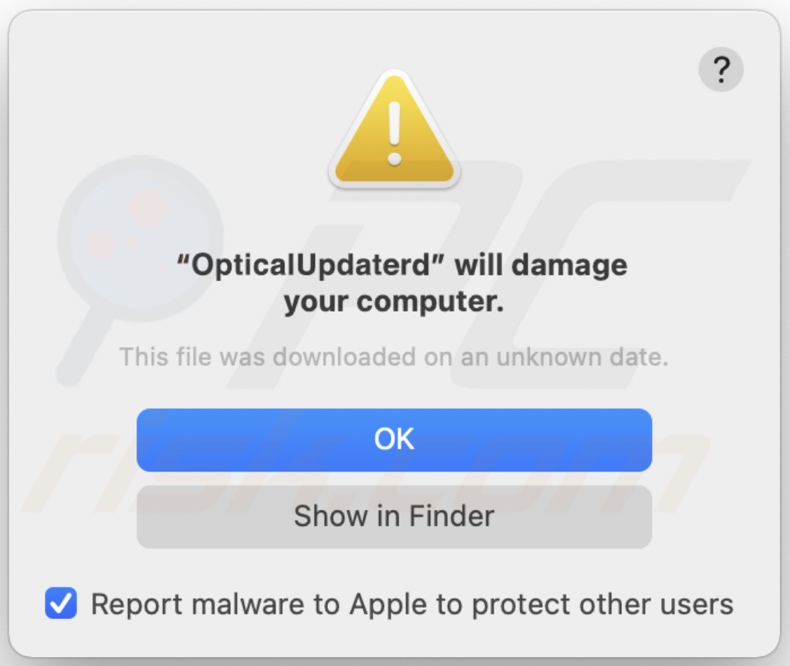
Text presented in this pop-up:
"OpticalUpdaterd" will damage your computer.
This file was downloaded on an unknown date.
OK
Show in Finder
Deceptive installer (fake Flash Player updater) promoting OpticalUpdater adware.
First installation step:
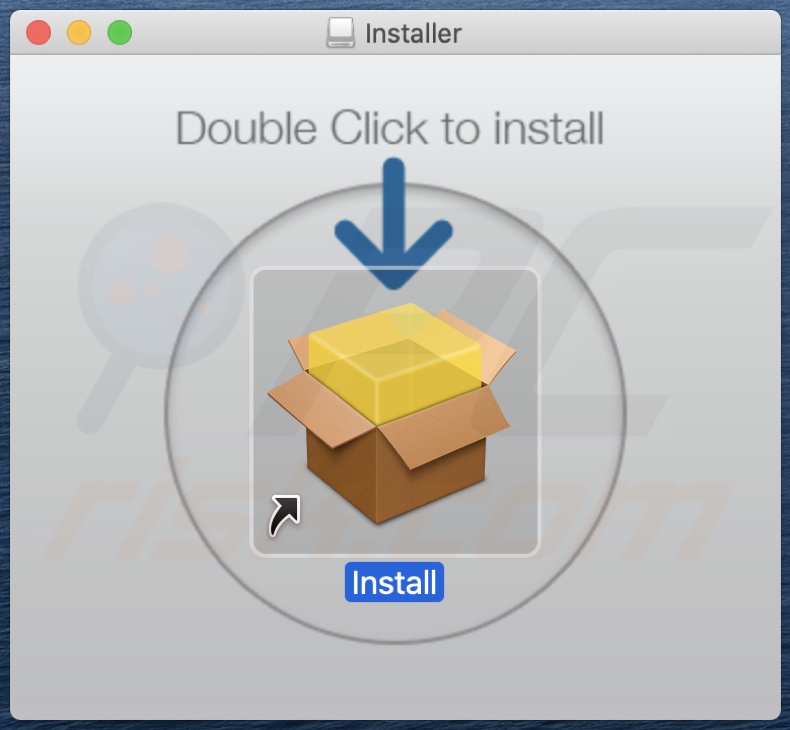
Second installation step:
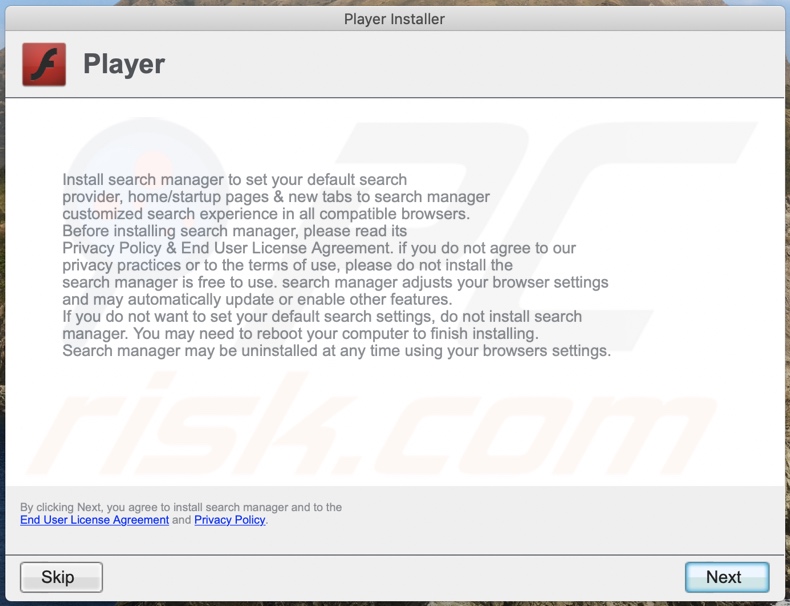
Files related to the OpticalUpdater adware that need to be removed:
- /Library/LaunchDaemons/com.OpticalUpdater.system.plist
- /Library/Application Support/.[random_string]/System/com.OpticalUpdater.system/OpticalUpdater.system
- ~/Library/LaunchAgents/com.OpticalUpdater.service.plist
- ~/Library/Application Support/.[random_string]/Services/com.OpticalUpdater.service/OpticalUpdater.service
IMPORTANT NOTE! In some cases malicious applications like OpticalUpdater alter system proxy settings, thereby causing unwanted redirects to a variety of dubious websites.
The redirects are likely to remain even after removing the application itself. Thus, you must restore them manually.
Step 1: Click on the gear icon in the Dock to navigate to the system settings. If the icon is not present in the Dock, you can find it in the Launchpad.
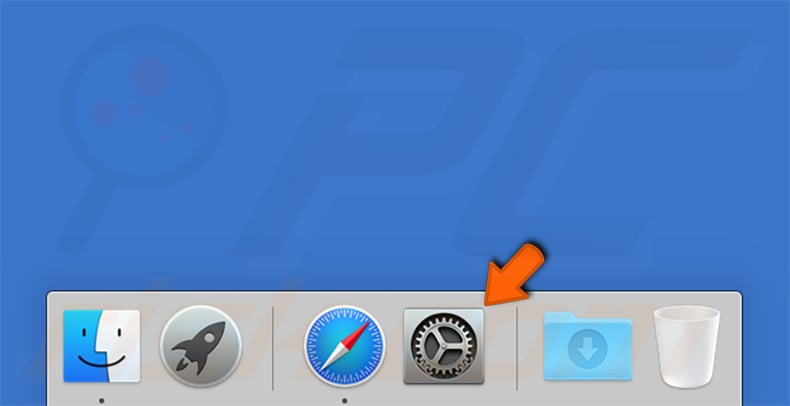
Step 2: Navigate to the Network settings.
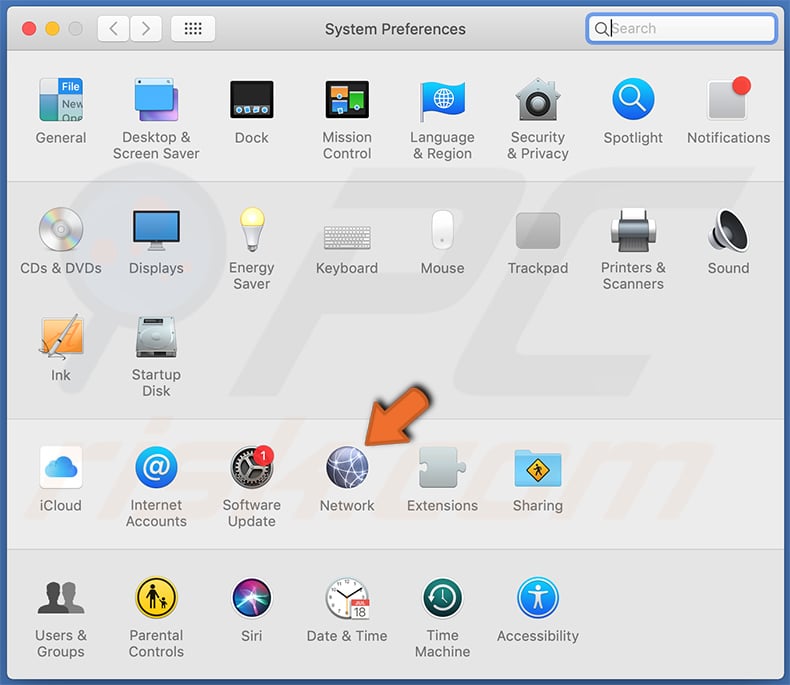
Step 3: Select the connected network and click "Advanced...".
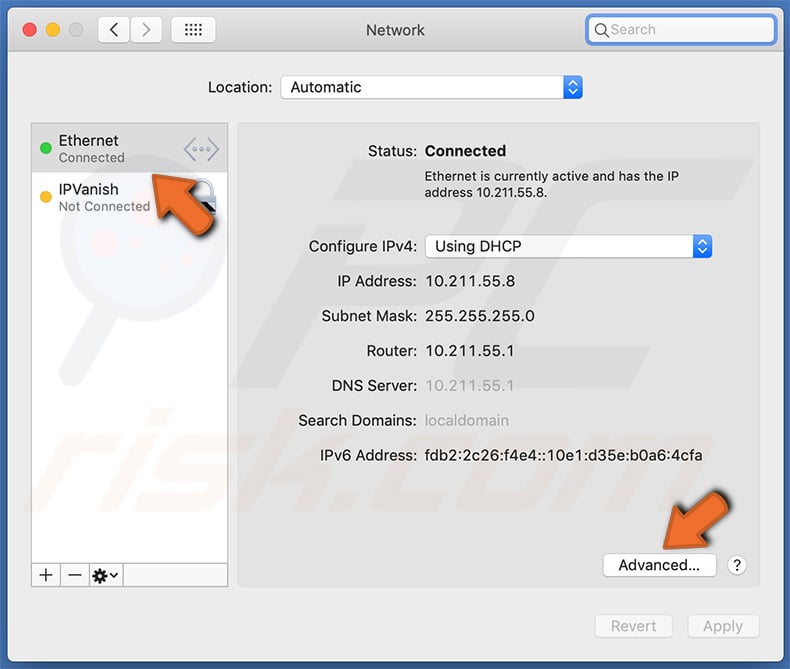
Step 4: Click on the "Proxies" tab and untick all the protocols. You should also assign the settings of each protocol to the default: "*.local, 169.254/16".
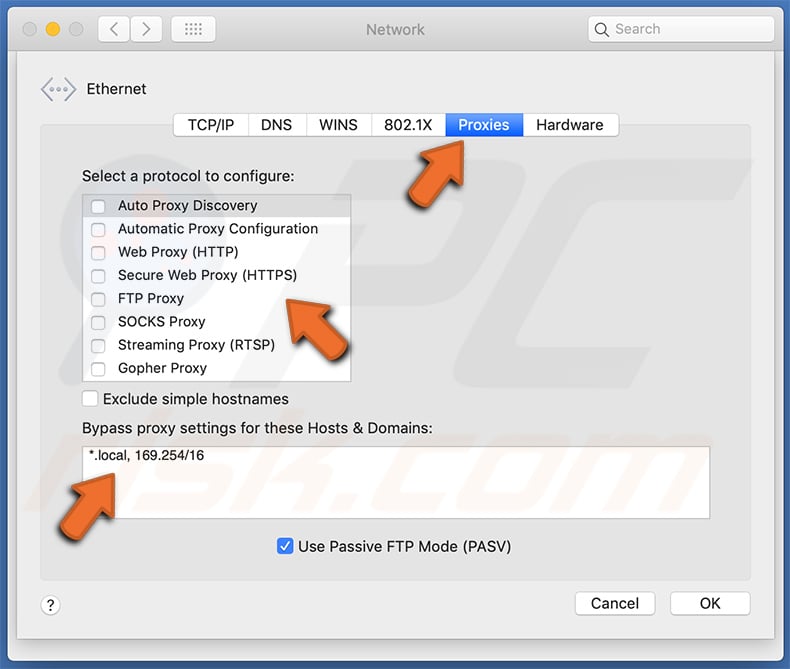
Instant automatic malware removal:
Manual threat removal might be a lengthy and complicated process that requires advanced IT skills. Combo Cleaner is a professional automatic malware removal tool that is recommended to get rid of malware. Download it by clicking the button below:
DOWNLOAD Combo CleanerBy downloading any software listed on this website you agree to our Privacy Policy and Terms of Use. To use full-featured product, you have to purchase a license for Combo Cleaner. 7 days free trial available. Combo Cleaner is owned and operated by RCS LT, the parent company of PCRisk.com.
Quick menu:
- What is OpticalUpdater?
- STEP 1. Remove OpticalUpdater related files and folders from OSX.
- STEP 2. Remove OpticalUpdater ads from Safari.
- STEP 3. Remove OpticalUpdater adware from Google Chrome.
- STEP 4. Remove OpticalUpdater ads from Mozilla Firefox.
Video showing how to remove OpticalUpdater adware using Combo Cleaner:
OpticalUpdater adware removal:
Remove OpticalUpdater-related potentially unwanted applications from your "Applications" folder:

Click the Finder icon. In the Finder window, select "Applications". In the applications folder, look for "MPlayerX","NicePlayer", or other suspicious applications and drag them to the Trash. After removing the potentially unwanted application(s) that cause online ads, scan your Mac for any remaining unwanted components.
DOWNLOAD remover for malware infections
Combo Cleaner checks if your computer is infected with malware. To use full-featured product, you have to purchase a license for Combo Cleaner. 7 days free trial available. Combo Cleaner is owned and operated by RCS LT, the parent company of PCRisk.com.
Remove adware-related files and folders

Click the Finder icon, from the menu bar. Choose Go, and click Go to Folder...
 Check for adware generated files in the /Library/LaunchAgents/ folder:
Check for adware generated files in the /Library/LaunchAgents/ folder:

In the Go to Folder... bar, type: /Library/LaunchAgents/

In the "LaunchAgents" folder, look for any recently-added suspicious files and move them to the Trash. Examples of files generated by adware - "installmac.AppRemoval.plist", "myppes.download.plist", "mykotlerino.ltvbit.plist", "kuklorest.update.plist", etc. Adware commonly installs several files with the exact same string.
 Check for adware generated files in the ~/Library/Application Support/ folder:
Check for adware generated files in the ~/Library/Application Support/ folder:

In the Go to Folder... bar, type: ~/Library/Application Support/

In the "Application Support" folder, look for any recently-added suspicious folders. For example, "MplayerX" or "NicePlayer", and move these folders to the Trash.
 Check for adware generated files in the ~/Library/LaunchAgents/ folder:
Check for adware generated files in the ~/Library/LaunchAgents/ folder:

In the Go to Folder... bar, type: ~/Library/LaunchAgents/

In the "LaunchAgents" folder, look for any recently-added suspicious files and move them to the Trash. Examples of files generated by adware - "installmac.AppRemoval.plist", "myppes.download.plist", "mykotlerino.ltvbit.plist", "kuklorest.update.plist", etc. Adware commonly installs several files with the exact same string.
 Check for adware generated files in the /Library/LaunchDaemons/ folder:
Check for adware generated files in the /Library/LaunchDaemons/ folder:

In the "Go to Folder..." bar, type: /Library/LaunchDaemons/

In the "LaunchDaemons" folder, look for recently-added suspicious files. For example "com.aoudad.net-preferences.plist", "com.myppes.net-preferences.plist", "com.kuklorest.net-preferences.plist", "com.avickUpd.plist", etc., and move them to the Trash.
 Scan your Mac with Combo Cleaner:
Scan your Mac with Combo Cleaner:
If you have followed all the steps correctly, your Mac should be clean of infections. To ensure your system is not infected, run a scan with Combo Cleaner Antivirus. Download it HERE. After downloading the file, double click combocleaner.dmg installer. In the opened window, drag and drop the Combo Cleaner icon on top of the Applications icon. Now open your launchpad and click on the Combo Cleaner icon. Wait until Combo Cleaner updates its virus definition database and click the "Start Combo Scan" button.

Combo Cleaner will scan your Mac for malware infections. If the antivirus scan displays "no threats found" - this means that you can continue with the removal guide; otherwise, it's recommended to remove any found infections before continuing.

After removing files and folders generated by the adware, continue to remove rogue extensions from your Internet browsers.
Remove malicious extensions from Internet browsers
 Remove malicious Safari extensions:
Remove malicious Safari extensions:

Open the Safari browser, from the menu bar, select "Safari" and click "Preferences...".

In the preferences window, select "Extensions" and look for any recently-installed suspicious extensions. When located, click the "Uninstall" button next to it/them. Note that you can safely uninstall all extensions from your Safari browser - none are crucial for regular browser operation.
- If you continue to have problems with browser redirects and unwanted advertisements - Reset Safari.
 Remove malicious extensions from Google Chrome:
Remove malicious extensions from Google Chrome:

Click the Chrome menu icon ![]() (at the top right corner of Google Chrome), select "More Tools" and click "Extensions". Locate all recently-installed suspicious extensions, select these entries and click "Remove".
(at the top right corner of Google Chrome), select "More Tools" and click "Extensions". Locate all recently-installed suspicious extensions, select these entries and click "Remove".

- If you continue to have problems with browser redirects and unwanted advertisements - Reset Google Chrome.
 Remove malicious extensions from Mozilla Firefox:
Remove malicious extensions from Mozilla Firefox:

Click the Firefox menu ![]() (at the top right corner of the main window) and select "Add-ons and themes". Click "Extensions", in the opened window locate all recently-installed suspicious extensions, click on the three dots and then click "Remove".
(at the top right corner of the main window) and select "Add-ons and themes". Click "Extensions", in the opened window locate all recently-installed suspicious extensions, click on the three dots and then click "Remove".

- If you continue to have problems with browser redirects and unwanted advertisements - Reset Mozilla Firefox.
Frequently Asked Questions (FAQ)
What harm can adware cause?
Advertisements displayed by adware can promote content capable of causing problems (e.g., system infections, privacy issues, financial losses, etc.). This software can decrease browsing quality and system performance. Additionally, advertising-supported software usually has data-tracking functionalities – hence, it is classed as a privacy threat.
What does adware do?
Adware is designed to display advertisements on various interfaces. Furthermore, software within this classification may also be capable of force-opening websites and gathering sensitive information.
How do adware developers generate revenue?
Adware generates revenue primarily through affiliate programs by endorsing content. The developers may earn commissions from ad clicks, site visits, file downloads, product purchases, service subscriptions, or similar.
Will Combo Cleaner remove OpticalUpdater adware?
Yes, Combo Cleaner will scan your system and eliminate detected adware-type applications. Keep in mind that manual removal (unaided by security programs) might not be an ideal solution. In some cases, file leftovers can remain hidden within the system – following the software's manual removal. Therefore, it is paramount to eliminate advertising-supported software thoroughly.
Share:

Tomas Meskauskas
Expert security researcher, professional malware analyst
I am passionate about computer security and technology. I have an experience of over 10 years working in various companies related to computer technical issue solving and Internet security. I have been working as an author and editor for pcrisk.com since 2010. Follow me on Twitter and LinkedIn to stay informed about the latest online security threats.
PCrisk security portal is brought by a company RCS LT.
Joined forces of security researchers help educate computer users about the latest online security threats. More information about the company RCS LT.
Our malware removal guides are free. However, if you want to support us you can send us a donation.
DonatePCrisk security portal is brought by a company RCS LT.
Joined forces of security researchers help educate computer users about the latest online security threats. More information about the company RCS LT.
Our malware removal guides are free. However, if you want to support us you can send us a donation.
Donate
▼ Show Discussion